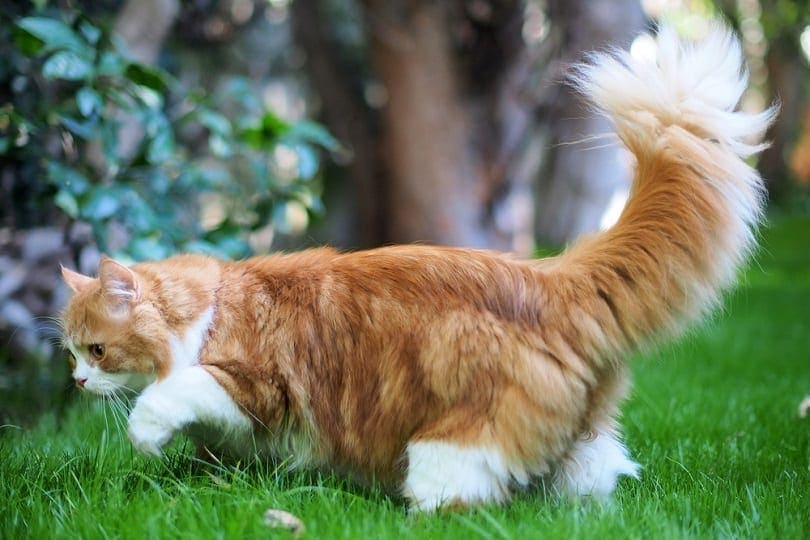Persian Cat vs Himalayan Cat: Key Differences (with Pictures)
By Ed Malaker
Updated on

Click to Skip Ahead
In this article, we will look at the Persian and Himalayan cat breeds. If you are in the market for a new pet, keep reading while we look at the appearance, characteristics, and differences between these two popular breeds to help you choose the perfect feline companion.
Visual Differences

At a Glance
- Origin: Iran
- Size: 8–10 inches
- Lifespan: 12–18 years
- Domesticated?: Yes
- Origin: Iran
- Size: 8–10 inches
- Lifespan: 12–18 years
- Domesticated?: Yes
Persian Cat Overview

Origin
The Persian cat is a long-haired breed that was first documented in the 1600s in Persia, a country that is now modern-day Iran. No one is sure how the Persian cat got its long hair since there are no long-haired African wildcats, which most experts believe is the ancestor of the common house cat.
Appearance
The Persian cats have short legs and short, broad bodies. They are well-known for their long hair and bushy tails with slightly less hair around the shoulders and pointier ears than their Angora relatives. Persian cats come in a variety of color patterns, including a solid color, silver and golden, blue-black, cream, tortoiseshell, blue-cream smoke, tabby, and calico. And those are just a few of the color patterns that Persian cats possess.
There are also two types of Persian cats: traditions (or “doll-face”) and peke-face (or “ultra-typing”). Traditional Persian cats do not have a flat face and closely resemble the Angora cat breed, a close relative, and you can still find this type from select breeders though the modern style with the flatter face is more common. However, due to the flat face of the peke-face Persians, they often have sinus problems and difficulty breathing.

Characteristics
The Persian cat can be “talkative”, but they love to find comfortable spots to lay in and nap. That makes them a perfect apartment companion due to their desire to lounge around and sit in a window. It’s friendly and enjoys being around people, even children who tend to make a big fuss over their long hair. It’s tolerant of petting and doesn’t mind other pets as long as it has a spot of its own. It’s also a healthy breed, with most cats living more than 12 years.
Himalayan Overview

Origin
The Himalayan cat is a mixed breed that uses the Persian and Siamese cat breeds as parents. The Persian cat originated from modern-day Iran and the Siamese cat from modern-day Thailand. Scientists from Sweden created the Himalayan cat in the 1920s, and it gained significant popularity by the 1950s. Its popularity continues today as it’s one of the most sought-after breeds. This mix allows the cat to suffer fewer health problems while adapting to more climates.
Appearance
Himalayan cats have long hair, short legs, and round body. They stand an inch or two taller than the Persian cat and usually have a colorpoint coat, which is a type of albinism that causes most of its fur to be white or cream colored, except the cooler areas of the body like the face, tail, and legs. Those parts of their body have different colors, including the blue point, lilac point, seal point, chocolate point, red point, and cream point.
There are two types of Himalayan cats: traditional (or the “doll-face”) and the peke-face (or the ultra-face). The traditional breed has a longer face, whereas the peke-face has a more squashed face. Like the Persian cat breeds, the peke-faced Himalayans can be prone to breathing difficulty and watery eyes due to their flattened faces.

Characteristics
The crossbreeding of the Siamese cat with the Persian cat results in a more energetic cat that you will often see chasing after toys or bugs. However, it still enjoys being around humans and has a good personality, accepting of children and other pets. It will also do plenty of lounging in the sunshine and likes to sit on your lap at night. The downside to this breed is that its heavy shedder requires frequent brushing to remove loose hair and avoid tangles and knots.
What Are the Differences Between Persian and Himalayan Cats?
The most noticeable difference between the Persian and Himalayan cat breeds is the coat. Persian cats can have a wide variety of colors and patterns. In contrast, the Himalayan cat will usually have a colorpoint coat that only allows color on the cooler parts of the body. You can only find a few different colors with the colorpoint coat, so you are much more likely to find two Himalayan cats that look similar. Other differences include a slightly increased energy level in the Himalayan cat due to its Siamese genes, and it’s a little bit larger with a fatter body.
Which Breed Is Right for You?
Both Persian and Himalayan cats make excellent pets, and either would make a fine choice in a small or large home. Both cats get along well with children and other pets. Additionally, both breeds love being near their human companions and enjoy a good snuggle session. If you were looking for a cat with an instantly recognizable colorpoint coat, then the Himalayan cat makes a great choice. If you see plenty of variety and something unique, you have a better chance with the Persian.
We hope you have enjoyed reading this short guide and found the answers to your questions. If we have helped you choose your next pet, please share this article about the differences between the Persian and Himalayan cats on Facebook and Twitter.
Featured Image Credit: Left: Persian Cat: Patrick Foto, Shutterstock | Right: Himalayan Cat: MULTI ILHAM ANUGRIYA, Shutterstock











